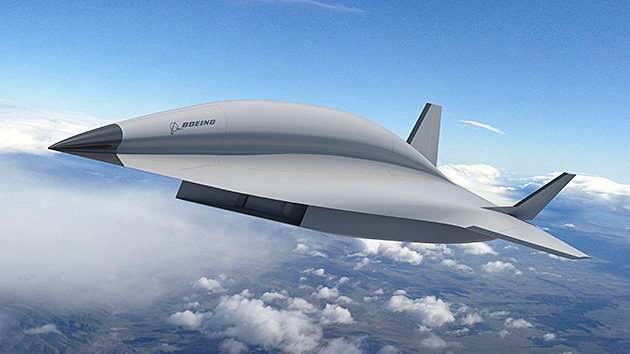Boeing's hypersonic concept is targeted for military applications. Credit: Boeing
Boeing gave us a tantalizing thought as a February opener to the coming weeks to end winter. "...an aircraft that can fly more than five times the speed of sound, jetting across world in one to three hours. If Boeing has any say, it'll be a reality in 10-20 years."
In the previous month, Boeing had piqued imaginations when it revealed a hypersonic aircraft design at a conference—marking its place in the arena of hypersonic planes.
It was unveiled in model form at the American Institute of Aeronautics and Astronautics SciTech forum in Florida. However, Boeing said it was "still in early research and design stages."
More technology advancements need to be made, said Boeing, but "we could get there as soon as 10 years from now."
What's more, the design revealed at the forum is not the sole design but one of several on the company's hypersonic aircraft agenda. "This is one of several concepts and technologies we're studying for a hypersonic aircraft," said Boeing Research & Technology's Kevin Bowcutt. He is senior technical fellow of hypersonics.
Application of the concept shown at the forum? Intelligence, surveillance/reconnaissance, and strike capabilities.
Reports outside Boeing said Boeing is looking at a future Mach 5-plus strike-and-reconnaissance aircraft. NBC News said, "At low speeds for takeoff and landing, the sleek plane would be powered by a turbine engine, much like a regular commercial plane. But for the main portion of flights, it would switch over to an engine called a dual-mode ramjet that can only operate at speeds above Mach 3."
According to Popular Mechanics, the move is a competitive challenge to Lockheed Martin, which built the SR-71.
Observers commented that Boeing's entry will try to catch up with an upscaled "SR-72" platform that could follow.
Tyler Rogoway, The Drive wrote about an envisioned design and test evolution for the proposed hypersonic program. He said it was all about "creating a fighter-sized demonstrator vehicle for initial testing, and then upscaling that design into a large operational aircraft roughly the same size as the SR-71 Blackbird."
If they do move to deliver a hypersonic strike and reconnaissance plane, what would it look like?
Popular Mechanics built a word picture of " a scaled, single-engine, proof-of-concept demonstrator aircraft about the size of an F-16 before moving on to a full-scale, twin-engine aircraft the size of the 107-foot-long SR-71."
Popular Mechanics also noted that Boeing and Lockheed's designs were very similar, with both planning (1) to use a combined-cycle engine that uses a conventional turbojet to accelerate to roughly Mach 3, and then (2) a dual ramjet/scramjet to make the jump to hypersonic speeds.
Rogoway weighed in with a comment about the two: "Regardless of who stands the best chance of becoming America's prime hypersonic plane provider, one thing is clear, in an age of where peer-state competition is once again all the rage, hypersonic vehicles of all types are slowly creeping onto center stage, and America's potential enemies aren't sitting still in this regard either."
© 2018 Tech Xplore
























